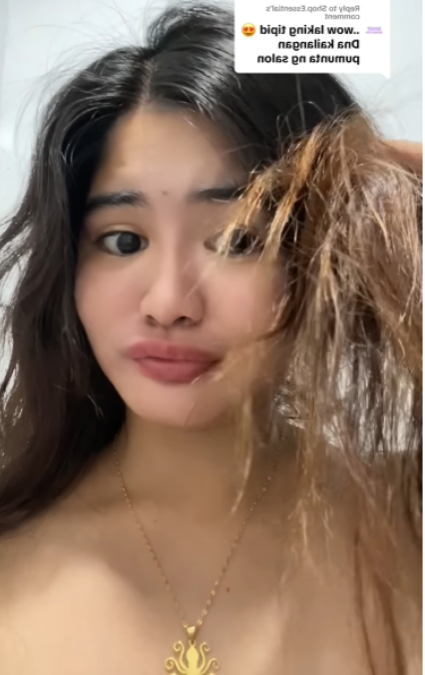In the fast-paced world of digital content creation, where the boundaries between entertainment and ethical considerations often blur, a recent incident has ignited a fervent debate on consent, exploitation, and responsible content production. The Kamangyan Viral Video Shampoo Real Video, originating from the Filipino YouTube channel Sulasok TV, has thrust itself into the spotlight, sparking widespread controversy and prompting a multifaceted discourse on various online platforms.
At the center of the controversy is a video featuring Kamangyan, a middle-aged Filipina woman, sensually applying shampoo in what appears to be a private moment. The provocative nature of the footage, coupled with allegations of potential exploitation and ethical violations, has triggered intense scrutiny and condemnation from online communities, news outlets, and social media users.
This article endeavors to unravel the layers of the Kamangyan Shampoo video controversy, delving into the ethical considerations surrounding its creation, the online discourse that has unfolded on platforms like Reddit and Twitter, and the legal implications that may arise. As the story continues to evolve, the incident serves as a critical examination of the digital content creation landscape, challenging creators, platforms, and audiences to confront the ethical dilemmas inherent in the pursuit of online fame. Through a comprehensive exploration of the unfolding controversy, this article aims to shed light on the broader implications for the industry and society at large.

II. Breakdown of the Sulasok TV Kamangyan Shampoo Video
The video, uploaded by Filipino YouTube channel Sulasok TV, showcases Kamangyan, a middle-aged woman, sensually applying shampoo and showering herself. The provocative nature of the footage, including close-ups of her body, has sparked controversy and accusations of exploitation. While Sulasok TV claims Kamangyan was aware and gave consent, skepticism and outrage persist among viewers, questioning the ethics of the video’s creation.
III. Online Reaction and Discourse on the Kamangyan Shampoo Issue
The viral video has become a focal point for online discussion, particularly on platforms like Reddit and Twitter. The r/ChikaPH subreddit has served as a hub for in-depth analysis, dissecting the video’s context, contents, and implications. Twitter, through hashtags like #KamangyanScandal and #SulasokTV, has propelled the discourse into the mainstream, exposing the controversy to a wider audience. The interconnected dialogue on these platforms has pressured involved parties to address the ethical concerns raised.

IV. Mercedes Lasac’s Involvement and Insights on the Sulasok TV Kamangyan Viral Video
Mercedes Lasac, through her vlog #24, has played a crucial role in the ongoing saga. She alleges that the woman in the video is a real and unsuspecting person who did not consent to the suggestive imagery. Lasac’s insights have added a personal dimension to the controversy, shedding light on potential exploitation and unethical practices by Sulasok TV. While some critics question the lack of concrete evidence, Lasac’s vlog has fueled a broader conversation about consent, women’s rights, and protecting individuals from online exploitation.

V. Media Coverage and Public Response
Media outlets have picked up on the Kamangyan Shampoo video controversy, amplifying its reach and impact. Various news sources have reported on the accusations against Sulasok TV, the online discourse on platforms like Reddit and Twitter, and Mercedes Lasac’s role in bringing attention to the potential exploitation involved. Public response has been diverse, with individuals expressing a range of opinions on social media. The controversy has become a topic of debate not only among internet users but also within mainstream discussions on content ethics.
VI. Legal Implications and Sulasok TV’s Response
The legal ramifications of the Kamangyan Shampoo video remain uncertain. While the controversy revolves around issues of consent and ethical content creation, potential legal consequences for Sulasok TV depend on the veracity of the claims and the nature of the agreement between Kamangyan and the creators. Sulasok TV’s response to the allegations will play a crucial role in determining its future standing. As the story develops, legal experts may weigh in on whether any laws or ethical standards were violated.
@ryanmagpulong #kamangyan #kamangyanvlog #kamangyanvlogs #kamangyanshampooviral #kamangyanviralvideo #stopsharing #stopspreading ♬ original sound – Ryan magpulong
VII. Lessons Learned and Industry Reflection
The Kamangyan Shampoo video controversy prompts the digital content creation industry to reflect on its practices. Creators and platforms may reevaluate their approaches to ensure ethical standards are met, emphasizing transparency, consent, and responsible content creation. The incident serves as a case study for influencers, content creators, and online platforms to understand the potential consequences of disregarding ethical boundaries. It also highlights the importance of fostering a digital environment that prioritizes the well-being and dignity of individuals featured in online content.
VIII. Conclusion
The Kamangyan Viral Video Shampoo Real Video controversy has sparked a multifaceted discussion about online content creation, ethics, and accountability. As the story continues to unfold, the impact on the individuals involved, the creators, and the industry as a whole remains uncertain. This incident emphasizes the need for a more responsible and ethical approach to content creation in the digital age, where the line between public and private can blur rapidly. The lessons learned from this controversy can shape the future landscape of online content, influencing how creators navigate the delicate balance between entertainment and ethical considerations.
